Layang-Layang
Borneo, Malaysia Layang-Layang, Island of Swallows and Fish
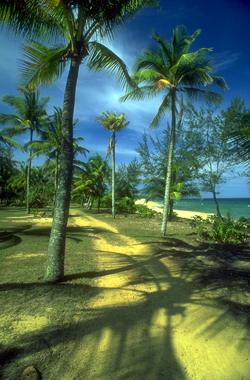 I often daydream of being somewhere in the middle of nowhere. Layang-Layang is only a sand spit in the center of the South China Sea. No fax. And a phone that sometimes works.
I often daydream of being somewhere in the middle of nowhere. Layang-Layang is only a sand spit in the center of the South China Sea. No fax. And a phone that sometimes works.
As the clouds part on our decent to Layang-Layang, a speck of sand quickly appears on the horizon. The oval island is made from 13 coral reefs linked together with a large lagoon in the center. The entire island spans only 1.2 km in length, but sports some of the best diving in the world.
The sounds of the two propellers of the 12 seat plane heighten as we ready for the landing. Once used only as a Malaysian military base, the island has just opened a 5-star hotel to cater to those in search of excellent diving combined with luxury accommodations.
As the plane settles onto the runway, it comes to rest midway, turns, backs up, and stops only a few meters from what first appeared to be the air terminal. But this turns out to be the luxury hotel. Our dive gear is unloaded and carried from the runway to our rooms.
The word Layang-Layang (pronounced Lay-an) means many swallows, for the island is a refuge for six different species of swallows. Just north of the hotel is an area set aside as a bird sanctuary where flocks of swallows rule the sky. At sunset, the birds gather to cloud the sky and call to the approaching night. Several other species of bird also rest on Layang-Layang en route to their home islands, promising more surprises above the waterline.
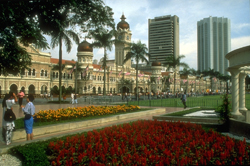 Kuala Lumpur, the largest city in Malaysia, is the port of call, accessible on Malaysian Airlines from any international airport. From there, you need to connect to the city of Kota Kinabalu, in the Malaysian state of Sabah on the island of Borneo. Generally, an overnight is required in either place to make the connection to the one and a quarter hour flight to Layang-Layang Island Resort.
Kuala Lumpur, the largest city in Malaysia, is the port of call, accessible on Malaysian Airlines from any international airport. From there, you need to connect to the city of Kota Kinabalu, in the Malaysian state of Sabah on the island of Borneo. Generally, an overnight is required in either place to make the connection to the one and a quarter hour flight to Layang-Layang Island Resort.
The hours on Layang-Layang are filled with diving the outer wall around the island, and relaxing next to the pool of this luxury resort hotel. The fine meals are timed around the diving, and there is always time for afternoon tea. The hotel, which only opened in April of 1995, is fully operational with more facilities planned including a floating restaurant overlooking a new beach on the inner lagoon.
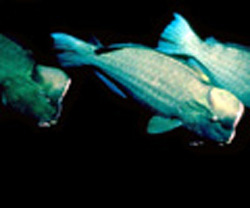 Most of the reef is submerged, except at very low tide when the coral heads peek above the surface. The island rises out of the surrounding 1,800 meter sea floor. This is the principal reason why the diving--especially the wall dives--and the marine life are so spectacular.
Most of the reef is submerged, except at very low tide when the coral heads peek above the surface. The island rises out of the surrounding 1,800 meter sea floor. This is the principal reason why the diving--especially the wall dives--and the marine life are so spectacular.
Kieko, our female divemaster, arrived in March to prepare for the first year of operation. The resort is only open between April and October as this portion of the South China Sea can be hit by monsoon weather. The fast twin-haul boats catering to small groups of up to 12 divers, offers safe, well-organized and personal diving. Kieko, like the other divemasters, is still discovering new and exciting areas of the reef. The circumference is so large that it is hard to predict where the big fish are; yet surprises are frequent, such as a visiting Whale or Hammerhead shark, especially in April.
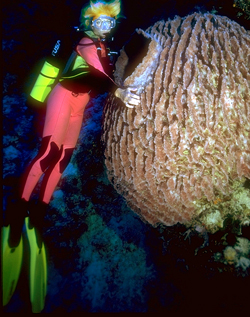 The wall diving is excellent with large yellow gorgonian fans, barrel sponge, and coral overhangs. Current is not much of a problem and many dives reach more than 30 meters. Whitetip and leopard sharks pace along the deeper sections of the walls.
The wall diving is excellent with large yellow gorgonian fans, barrel sponge, and coral overhangs. Current is not much of a problem and many dives reach more than 30 meters. Whitetip and leopard sharks pace along the deeper sections of the walls.
Shark`s Cave is one of the favorite sites. A small opening in the rock wall at 40 meters narrows to the rear, revealing a crack only large enough to squeeze in a few Whitetip sharks. With our tanks pinned against the top of the crack preventing us from edging forward, these denizens of the deep appear more afraid of us than we are of them.
What first appeared as a seascape covered mostly in brown tones comes alive as one probes deeper. Fields of golden brown soft corals carpet many of the dive sites. The slopes of brown are interrupted by growths of leather coral and an occasional Tridachna Clam--as large as a meter across--with its protruding blue and green mantles. The brown fields are home to a myriad of fish from the Pyramid Butterfly fish, clownfish, Clown Triggerfish, Whitespotted Puffers, Lionfish, spadefish, and Sweetlips, to large schools of Brown Jacks and Sharpfin Barracuda.
After diving for several days, we decided that of the 14 dive sites that have been named since the operation opened, our favorites include West Point, East Point, Gorgorian and Shark`s Cave. These have deep segments with big fans and even bigger barrel sponges, with some measuring more than a meter. Shallow sections of the reef can be combined with these deeper dives to yield an overall fun-filled experience.
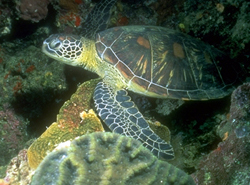 Of the seven species of sea turtles living in the world's oceans today, only four are known to nest in Malaysia. These are the Leatherback, the Hawksbill, the Green turtle, and the Olive Ridley. The Hawksbill turtle was spotted several times on the dives around Layang-Layang Island.
Of the seven species of sea turtles living in the world's oceans today, only four are known to nest in Malaysia. These are the Leatherback, the Hawksbill, the Green turtle, and the Olive Ridley. The Hawksbill turtle was spotted several times on the dives around Layang-Layang Island.
Although locals still collect turtle eggs for sale, concerned individuals and the Malaysian government are making some progress in the protection of turtles. Collection and hatching facilities have been set up on Sipadan Island, and along a 20 km beach in Terengganu on the eastern shore of the Malaysian peninsula. These protection efforts hopefully ensure that Layang-Layang will have plenty of turtles for divers to enjoy.
On our last day of diving we saw a pair of friendly Hawksbill turtles. Annie and I enjoyed playing with the pair as we rested after a rather deep segment of the dive. With my head buried in a hole, and fussing with the controls of my camera as often happens, I heard Annie shouting through her regulator...Shark! Shark! Shark!
Below, a 2-meter Leopard Shark was gently cruising the reef at 40 meters. Annie was in hot pursuit as she so wanted to kiss a shark for the camera. As the shark moved slowly along the reef, Annie pumped to reach the unsuspecting leopard. However, the shark was not interested in having its picture taken, let alone being kissed by Annie (no offense meant). In the shallows above West Point wall, we again breathed easy until our attention was caught by a school of jacks performing aquabatics in the shimmering sunlight. We were off again. This last dive was a wonderful finish to 6 days of very pleasant diving that is sure to satisfy both the novice and expert diver.
With our diving done, we packed our gear and lounged at poolside to await another fine meal and our return to Sabah in the morning. Looking out the window of the plane, Layang-Layang disappears quickly behind on the horizon. Back on Borneo, more adventures await.
Mount Kinabalu, highest peak in southern Asia, is one adventure that should not be missed. Assending to the 4,101 meter (13,455 feet) summit can be done in less than two days and provides a wonderful complement to the Layang-Layang diving experience. John Nair of Exotic Adventures can lead individuals and large groups up the mountain. His knowledge of the area, its vegetation and wildlife makes the trip an extra treat. He knows where to find the world's sweetest pineapple.
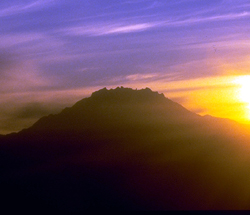 In 1964, Kinabalu Park was established to protect Mt. Kinabalu and its unique plant and wildlife. The hike affords an opportunity to pass through lowland rain forests to montane forest, cloud forest, subalpine meadows and then over the bare granite crown. Within each ecosystem, different plant life can be viewed including the famous Rafflesia--the world's largest flower. The tallest moss in the world, Dawsonia, standing almost a meter high, also grows on the mountain. John knows the mountain well and can point out several of the nine varieties of the large Pitcher plant in the jungle just seconds off the main path. These insect-eating plants are so large as to occasionally trap and digest mice and small rats!
In 1964, Kinabalu Park was established to protect Mt. Kinabalu and its unique plant and wildlife. The hike affords an opportunity to pass through lowland rain forests to montane forest, cloud forest, subalpine meadows and then over the bare granite crown. Within each ecosystem, different plant life can be viewed including the famous Rafflesia--the world's largest flower. The tallest moss in the world, Dawsonia, standing almost a meter high, also grows on the mountain. John knows the mountain well and can point out several of the nine varieties of the large Pitcher plant in the jungle just seconds off the main path. These insect-eating plants are so large as to occasionally trap and digest mice and small rats!
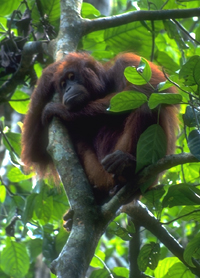 Malaysia offers an amazingly wide variety of adventures: combining fabulous wall diving with playing with large sea turtles and Whitetip and Leopard sharks; Kinabatangan River trips to see the Longtail Macaws and Proboscis monkey; seeing the Man of the Forest, the Orang-utan in the wild; climbing the majestic Mount Kinabalu, exploring the Gomantong Caves, whitewater rafting, getting a close-up look at jungle orchids and the insect-eating Pitcher plant, the world's largest flower Rafflesia, and much, much more.
Malaysia offers an amazingly wide variety of adventures: combining fabulous wall diving with playing with large sea turtles and Whitetip and Leopard sharks; Kinabatangan River trips to see the Longtail Macaws and Proboscis monkey; seeing the Man of the Forest, the Orang-utan in the wild; climbing the majestic Mount Kinabalu, exploring the Gomantong Caves, whitewater rafting, getting a close-up look at jungle orchids and the insect-eating Pitcher plant, the world's largest flower Rafflesia, and much, much more.
Along with this diversity of activities, which promises to excite and amaze, the ever changing land-and seascapes of Malaysia will satisfy even the most demanding adventurer. Layang-Layang is a mere speck of sand in the center of the South China Sea. Here we left behind the worries of the world. Sun, ocean, fish, birds, and of course, the fine cuisine are all we thought about. After a long week of diving and relaxation in this luxury dive resort, we could not help but think that this is the stuff that daydreams are made of.
Originally published in Scuba World Magazine
